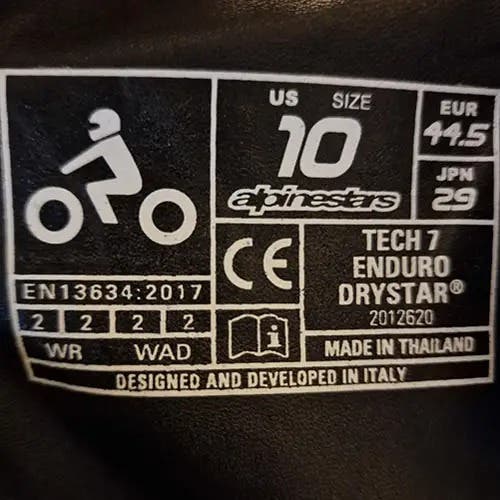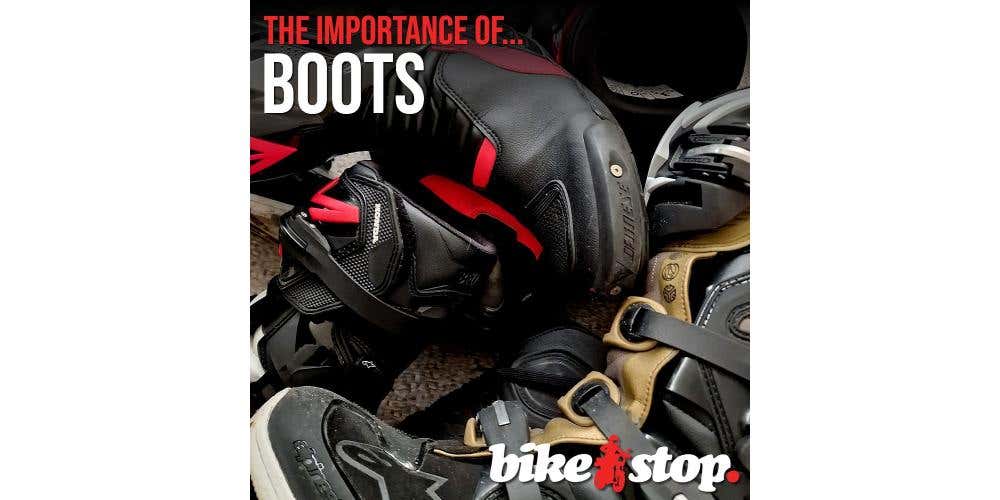In the first part of our “Importance Of” series, we looked at the tiniest part of our motorcycling gear ensemble, the humble earplug. In this part, we’re looking at something a little more substantial. Some are short and some are tall, some are big and bulky and some are as light as a feather, they can be warm and waterproof or ventilated and breezy, but whichever flavour they come in, the boot is one of the most important pieces of gear for motorcyclists.
I do cringe a little when I see people riding in trainers or other unsuitable footwear. I’ve even witnessed someone riding an R1 in a pair of Crocs. However, this isn’t just me hang-wringing and finger-wagging because someone is exercising their freedom of choice. Not at all. I worry because the types of injury sustained from a failure to wear the correct footwear are all quite hideous and unpleasant.
If you do choose to wear trainers, sandals, Crocs or clogs, you need to be aware of what is likely to occur should you be involved in an accident. The first thing to happen the moment your foot touches the ground is that your shoe will disappear. Think of the ease required to kick off even a well-laced pair of trainers and then think about that force relative to the force your Air Max will receive when coming into contact with tarmac at 30mph. Your shiny new Nikes will disappear behind you as you tumble down the road wearing only your socks. I haven’t conducted any research into the abrasion resistance properties of socks, but I’m fairly confident they wouldn’t last more than the blink of an eye. The skin and bone beneath the socks is likely to last as long as the sock itself. Don’t wear trainers.
Standards
Boots are designed to do a number of things to keep our feet safe. Firstly, they’re designed to stay on your foot. Whether you choose to use laced short boots, zipped sports or touring boots or massive MX boots with straps and buckles, they’re all designed to stay on your foot. Secondly, they’ve been specifically designed to protect your feet whilst riding a motorcycle. While many people consider sturdy work boots to be a suitable alternative, there are a number of downsides. Motorcycle boots concentrate their protective efforts against injuries sustained from twisting and horizontal crushing. Work boots tend to only protect against vertical crushing, i.e. heavy objects being dropped on your toes. It’s highly unlikely that someone will drop a car on your foot while you’re standing up. It’s far more likely a car will run over your foot whilst you’re lying down, but try not to dwell on that thought.
To ensure boots are safe, they need to meet the EN13634 standard.
If you take a peek inside a motorcycle boot, you'll see a panel showing the standard the boot has met. If you don't see this panel, it's maybe time to think about a new pair of boots. The panel gives details of the EN13634 standard, which pertains to motorcycle boots, but will vary depending on the year of classification. On the panel, you'll see an icon of a motorcycle with the EN13634 standard below. Underneath that, there will be either three or four boxes, depending on which standards year the boot was tested for.
Looking at the photo on the right, we can see the familiar motorcyclist icon, meaning the boots are intended for motorcycling. We can see the box denoting the EN13634 standard of 2017, and below it, we see four additional boxes, in this instance populated by '2's.
First box - Height: Simple enough, if it shows a '1', it's an ankle-high boot. If it shows a '2', it's a shin-high boot. This information may not be present if you only see three boxes, as per the 2010 standard.
Second box - Abrasion Resistance: Area A covers the sole, back and front of the boot. Area B covers everything else. Samples are taken from each area and held against a moving abrasive belt until a hole appears. Level 1 must last 1.5 seconds for Area A and 5 seconds for Area B. Level 2 must last 2.5 seconds for Area A and 12 seconds for Area B.
Third box - Impact Cut: A blade on a mounting block is dropped onto the boot. For Area A, the blade drops at 2m/s. For both Level 1 and Level 2 ratings, the blade mustn't penetrate more than 25mm. For Area B, the blade is dropped at 2.8m/s. For Level 1, the blade mustn't penetrate more than 25mm, and for Level 2, it can't exceed 15mm.
Fourth box - Transverse Rigidity: The boot is crushed between two metal plates to simulate a bike falling onto it. If it takes less than 1kN of force to compress the sole 20mm, it's a fail. If it takes between 1-1.4kN, it achieves a Level 1 pass. If it needs more than 1.5kN, it achieves Level 2.
There are optional tests available to achieve extended certification, too. In the photo, you'll notice 'WR' and 'WAD' designations, and it's possible you'll see other letters, too:
WR: If a boot lets in no more than 3cm/sq of water after a simulated 4,600 steps or walking 1km whilst submerged in water, it passes.
WAD: Water absorption and deabsorption. Basically, how quickly the boot holds and releases water.
B: Breathability and the test to ensure moisture can escape the boot.
SRA/SRB/SRC: Slip resistance. SRA is a pass for testing on a soapy ceramic floor, SRB is a pass for a glycerol-coated steel floor, and SRC means it passed both tests.
FO: The sole's resistance to fuel/oil. If the weight of a boot increases no more than 12% after being soaked in fuel for 22 hours, it's a pass.
As you can see, there's a lot going on with proper motorcycle boots, and it's all designed to keep your feet safe for the very specific activity of motorcycling.




Boot Types
There are as many different types of boot as there are types of motorcycle, and although there is a bit of overlap, it's best to use a boot which suits your bike and your style of riding. While you may be able to use a ventilated sport boot on an enormous adventure bike, it wouldn't be ideal to use a chunky MX boot on your Panigale. It's not dissimilar to the reasons why ballet dancers don't use rigger boots, although I would pay good money to watch Swan Lake if the ensemble were forced to use Alpinestars Tech 7s. Anyway, as a quick guide to what's available, here are the most common style of boot:
Short Boots
Suited to: Commuting, short distance travel
Model shown: Dainese Street Darker Gore-Tex
The short boot (also known as shorty or street boots) is ideal for commuting. As simple to put on and take off as a high-top sneaker, but with enough protection to make your journies safer. While they may not offer as much protection as other styles of boot in the list, they're a good balance between safety and convenience. They also have the added advantage of being casual enough to wear when you're off the bike, so you don't have to worry about taking another pair of shoes with you for when you arrive at your destination.
We've pictured the Dainese Street Darker boot, which is also waterproof, thanks to its breathable Gore-Tex membrane, so there's no need to worry about wet feet whilst you're commuting in less than desirable weather.


Touring Boots
Suited to: Touring, commuting, long-distance travel
Model shown: Dainese Nighthawk D1
The touring boot is possibly the next step up from a commuting boot. The boots are, as you may have guessed, taller than a short boot and offer an increased level of protection. They're typical available in both medium and tall heights. Touring boots are solid all-rounders, and regardless of the type of motorcycle you ride, they won't look out of place, unless perhaps you're taking part in a motocross event, but apart from that, you're all good.
Pictured on the right is the Dainese Nighthawk, which is a waterproof, breathable and lightweight option, sporting a medium heigh cut.


Sport Boots
Suited to: Sports bikes and going very fast indeed
Model shown: Sidi Rex CE
Now things are getting a little more serious. Sport boots offer vast levels of protection, especially around the ankles, as they're designed with high-speed spills in mind. They're a tall boot, that's flexible enough and light enough to be comfortable whilst riding a sports bike and typically feature more ventilation than other types of boot to stop your paws from getting all sweaty and horrible whilst attacking Donington. Many models feature replaceable components, typically toe sliders, which are easily eaten away when achieving Marquez-levels of lean angle.
It's not all track days and scariness, though. They're very good boots for casual riding, and although there are some waterproof versions available, they're probably more suited to riding when the sun's shining.
We've shown the Sidi Rex CE boot here, which features replaceable shin plates and plenty of ventilation. They look awesome, too.


Adventure Boots
Suited to: Adventure bikes, green-laning, touring
Model shown: Alpinestars Corozal
A big bike needs a big boot. Well, it doesn't need a big boot, but if 270kg of adventure bike is going to flop onto your ankle, you want a suitable level of protection. Adventure boots are super tall and designed to work both on- and off-road. They're a good balance between the two environments you're likely to encounter on an adventure bike. It's perhaps easier to think of them as having the protection of an MX/Enduro boot but with the comfort of a touring boot. Typically - but not always - waterproof with grippy soles, bulky shin plates and adjustable closure straps. They tend to have a rather bulky toe box, so it's possible you'll need to adjust the height of your shifter if you're used to touring or sports boots.
The model pictured is the Alpinestars Corozal, which is a tall, waterproof boot with high levels of protection for adventure bike riders. It's pretty much all you could want from an adventure boot.


MX/Enduro Boots
Suited to: Motocross, enduro and a bit of adventure biking
Model shown: Alpinestars Tech 7 Drystar Enduro
We've saved the biggest until last. These are the boots design for motocross, getting muddy and getting your foot down in corners. They're extremely rigid with only just enough movement in your toes to be able to change gear. They're also extremely heavy and cumbersome, relative to other types of boots. However, the weight and rigidity are byproducts of the massive amount of protection on offer. Once you're fully buckled in to a pair of MX/Enduro boots, you feel like everyfrom from your toes to the top of shins is invincible (but it's not, you're not Superman). While it's possible to use these boots on an adventure bike, you'll almost certainly have to adjust your shifter to accomodate them, and get used to a slightly different style of changing gear.
The model shown is the Alpinestars Tech 7 Enduro Drystar, which is a fully waterproof boot. I'm particularly fond of this boot as this is what I use when I'm exploring byroads of my chunky adventure bike.


Whatever your style of bike, your style of riding or your personal preference, please make sure you use proper boots. With so many styles available, in so many colours, suited to so many different types of foot, there's no reason to not use proper boots. As always, the team at Bike Stop are on hand to help guide you to something that will work for you.
Please, please don't wear trainers.
Or Crocs.






